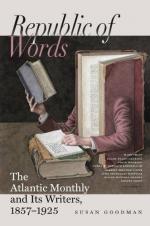uttered knowledge to us among the ghastly ruins of Hellas. It is good for us to lend a spiritual ear to these ancient whisperings, and hear nymph calling to nymph and faun to faun, as they caper merrily with the god Pan through the silence. It is good for us to listen to that “inextinguishable laughter” of the happy immortals of Olympus, ever mingling with all the voices of Nature and setting them to the still sweet music of humanity,—good, because so we are reminded how close we are to the outward world, and how all its developments are figurative expressions of our near relationships with the visible Beauty of things. Thus it is that the poetic truths of old religions exquisitely vindicate themselves; thus we find, even we moderns, with our downward eyes and our wrinkled brows, that we still worship at the mythological altars of childlike divinities; and when we can get away from the distracting Bedlam of steam-shrieks and machinery, we behold the secrets of our own hearts, the Lares and Penates of our own households, reflected in the “white ideals” on antique vases and medallions.
Abstract lines are the most concentrated expressions of human ideas, and, as such, are peculiarly sensitive to the critical tests of all theories of the Beautiful. Distinguished from the more usual and direct means by which artists express their inspirations and appeal to the sympathies of men, distinct from the common language of Art, which contents itself with conveying merely local and individual ideas, abstract lines are recognized as the grand hieroglyphic symbolism of the aggregate of human thought, the artistic manifestations of the great human Cosmos. The natural world, passing through the mind of man, is immediately interpreted and humanized by his creative power, and assumes the colors, forms, and harmonies of Painting, Sculpture, and Music. But abstract lines, as we find them in Architecture and in the ceramic arts, are the independent developments of this creative power, coming directly from humanity itself, and obtaining from the outward world only the most distant motives of composition. Thus it is an inevitable deduction that Architecture is the most human of all arts, and its lines the most human of all lines.
“A thing of beauty is a joy forever”;
and the affectionate devotion with which this gift is received by finite intelligences from the hand of God is expressed in Art, when its infinite depth can be so expressed at all, in a twofold language,— the one objective, the other subjective; the one recalling the immediate source of the emotion, and presenting it palpably to the senses, arrayed in all the ineffable tenderness of Art, which is Love,—the other, portraying rather the emotion than the cause of it, and by an instinctive and universal symbolism expressing the deep and serious joy with which the “thing of beauty” is welcomed to the heart. Hence come those lines which aesthetic writers term “Lines




